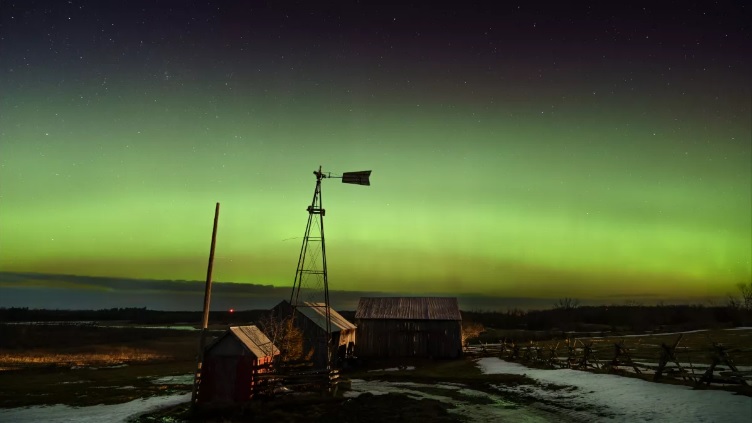“The potent solar storm intensified auroras, spreading as far south as Colorado and New Mexico.”
Today (March 24), Earth was hit by the most powerful solar storm in almost six years. However, to the surprise of space weather forecasters, the storm arrived without warning. The severity of the storm was rated as a severe G4 on the 5-grade scale used by the U.S. National Oceanic and Atmospheric Administration (NOAA) to measure space weather events.

The unexpected strength of the storm caused auroras to be visible as far south as New Mexico in the U.S. and resulted in a 90-minute delay for Rocket Lab’s launch. These storms, known as geomagnetic storms, are caused by solar material from coronal mass ejections (CME), which are large expulsions of plasma and magnetic fields from the sun’s atmosphere. In this case, the storm was triggered by a “stealth” CME, which is difficult to detect.
Initially, NOAA’s National Space Weather Service issued a “geomagnetic storm watch” on March 22, which was set to take place from March 23-25, and anticipated moderate G2 storm conditions on March 24. Although forecasters had been alerted, they were not prepared for the magnitude of a G4 storm. It wasn’t until 00:41 a.m. EDT on March 24 that NOAA increased the warning to a severe G4 storm.
This decision came after a stronger-than-expected G3 storm had escalated to a G4 at 12:04 a.m. EDT. U.S. space weather forecaster Tamitha Skov offered insight into why the space weather community underestimated the severity of this latest storm.
According to Skov, these stealth CMEs launch much more slowly than eruptive CMEs, making them difficult to observe without specialized training. Additionally, they can be “camouflaged” by other, denser structures emanating from the sun, leading to “problem geomagnetic storms” such as the current G4-level storm.
On March 22, NOAA’s National Space Weather Service issued a “geomagnetic storm watch” for March 23-25, predicting possible moderate G2 storm conditions on March 24. Although forecasters were not entirely surprised by the storm, they did not anticipate a G4 magnitude.
NOAA upgraded the warning to a severe G4 storm at 00:41 a.m. EDT (0441 GMT) on March 24, after a G3 storm (which was stronger than expected) escalated to a G4 at 12:04 a.m. EDT (0404 GMT). In an email to Space.com, U.S. space weather forecaster Tamitha Skov explained why the space weather community failed to predict this latest storm accurately. She noted that these “invisible” storms launch more slowly than eruptive CMEs, making them difficult to observe without specialized training.
Additionally, they can be “camouflaged” by other, more dense structures emanating from the sun, adding to the difficulty of observing them. This is why they are often the cause of “problem geomagnetic storms” like the current G4-level storm.
Skov’s latest YouTube video provides a more detailed explanation of the stealthy solar storms, which you can explore to learn further. NOAA ranks geomagnetic storms on a scale that ranges from G1 to G5. The G1 storm could cause a surge in auroral activity around the poles and minor disturbances in power supplies.
On the other hand, G5 storm, such as the Carrington Event that occurred in September 1859, is an extreme case that disrupted telegraph services globally and produced auroras that were visible as far south as the Bahamas.
Geomagnetic storms can pose a significant challenge for spaceflight, as they elevate the density of gases in Earth’s upper atmosphere, leading to increased drag on satellites and other spacecraft. For instance, in February 2022, SpaceX encountered problems when it lost nearly 40 brand-new Starlink satellites after they failed to reach orbit during a minor geomagnetic storm.
Rocket Lab recently experienced a delay in the launch of its mission due to a geomagnetic storm. The company announced the delay on Twitter and eventually launched the mission successfully at 5:14 a.m. EDT (0914 GMT) after assessing the evolving conditions of the storm.
Powerful geomagnetic storms have an additional consequence in the form of spectacular aurora displays. When high-energy particles from the sun collide with Earth’s atmosphere at incredible speeds of up to 45 million mph (72 million kph), the planet’s magnetic field directs them towards the poles.
This energizes the molecules in the atmosphere and creates the vivid and colorful spectacles that are typically confined to high latitude areas. However, on this occasion, people all around the globe were able to witness a breathtaking auroral display, which extended as far south as Colorado and New Mexico.
It is expected that we will experience more extreme space weather events, similar to this potent geomagnetic storm, as the sun progresses towards its 11-year solar activity cycle peak, which is anticipated to happen in 2025.